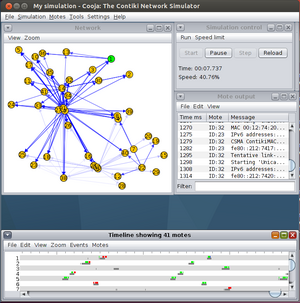Contiki

Screenshot of an Ubuntu system showing Contiki 2.6 running on 41 nodes forming an IPv6-RPL-6LoWPAN network in the Cooja Contiki network simulator.
|
|
| Developer | Adam Dunkels |
|---|---|
| Working state | Current |
| Source model | Open source |
| Initial release | 10 March 2003 |
| Latest release | 3.0 / 26 August 2015 |
| License | BSD |
| Official website | www |
Contiki is an operating system for networked, memory-constrained systems with a focus on low-power wireless Internet of Things devices. Extant uses for Contiki include systems for street lighting, sound monitoring for smart cities, radiation monitoring, and alarms. It is open-source software released under a BSD license.
Contiki was created by Adam Dunkels in 2002 and has been further developed by a worldwide team of developers from Texas Instruments, Atmel, Cisco, ENEA, ETH Zurich, Redwire, RWTH Aachen University, Oxford University, SAP, Sensinode, Swedish Institute of Computer Science, ST Microelectronics, Zolertia, and many others. The name Contiki comes from Thor Heyerdahl's famous Kon-Tiki raft.
Contiki provides multitasking and a built-in (TCP/IP stack), yet needs only about 10 kilobytes of random-access memory (RAM) and 30 kilobytes of read-only memory (ROM). A full system, including a graphical user interface, needs about 30 kilobytes of RAM.
Contiki is designed to run on types of hardware devices that are severely constrained in memory, power, processing power, and communication bandwidth. A typical Contiki system has memory on the order of kilobytes, a power budget on the order of milliwatts, processing speed measured in megahertz, and communication bandwidth on the order of hundreds of kilobits/second. Such systems include many types of embedded systems, and old 8-bit computers.
...
Wikipedia
